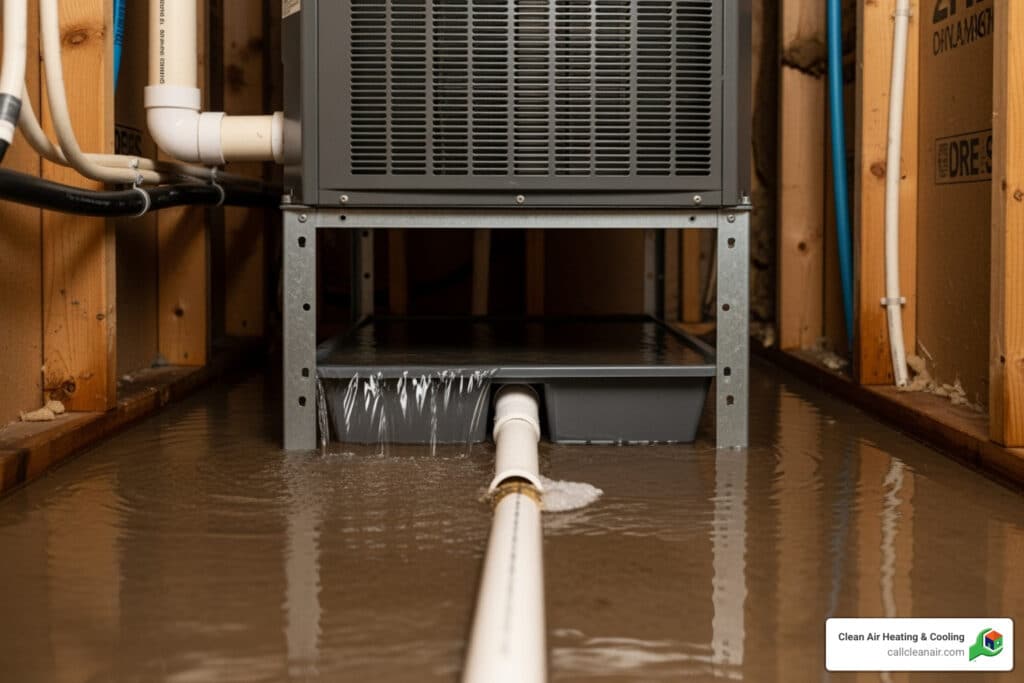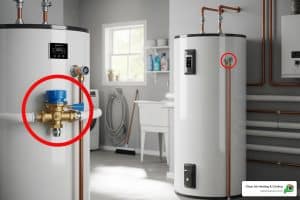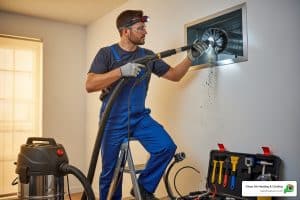Why a Clogged AC Drain Line Can Ruin Your Summer Comfort
With your AC drain line clogged, it can quickly turn your comfortable home into a humid, musty nightmare. Here’s what you need to know:
Quick Signs Your AC Drain Line is Clogged:
- Water pooling around your indoor AC unit
- Musty or moldy smells from your vents
- Your AC system shutting off unexpectedly
- Increased humidity levels inside your home
- Standing water in the condensate drain pan
Immediate Action Steps:
- Turn off your AC system at the breaker
- Locate the drain line (usually a PVC pipe near your indoor unit)
- Check for visible blockages at the access point
- Use a wet/dry vacuum to suction out debris
- Flush with hot water to confirm proper drainage
A clogged condensate drain line is a common AC problem, especially during humid Pacific Northwest summers. Fortunately, most clogs can be cleared with basic tools and some patience.
As your AC cools your home, it produces condensation that collects in a drain pan and flows out through a PVC pipe. When this line is blocked by dust, algae, or mold, water backs up and can cause serious damage.
I’m Colin Matei, Owner and President of Clean Air Heating & Cooling, and I’ve helped countless Whatcom County homeowners solve AC drain line clogged issues. I know that most homeowners can tackle this problem themselves with the right guidance and tools.
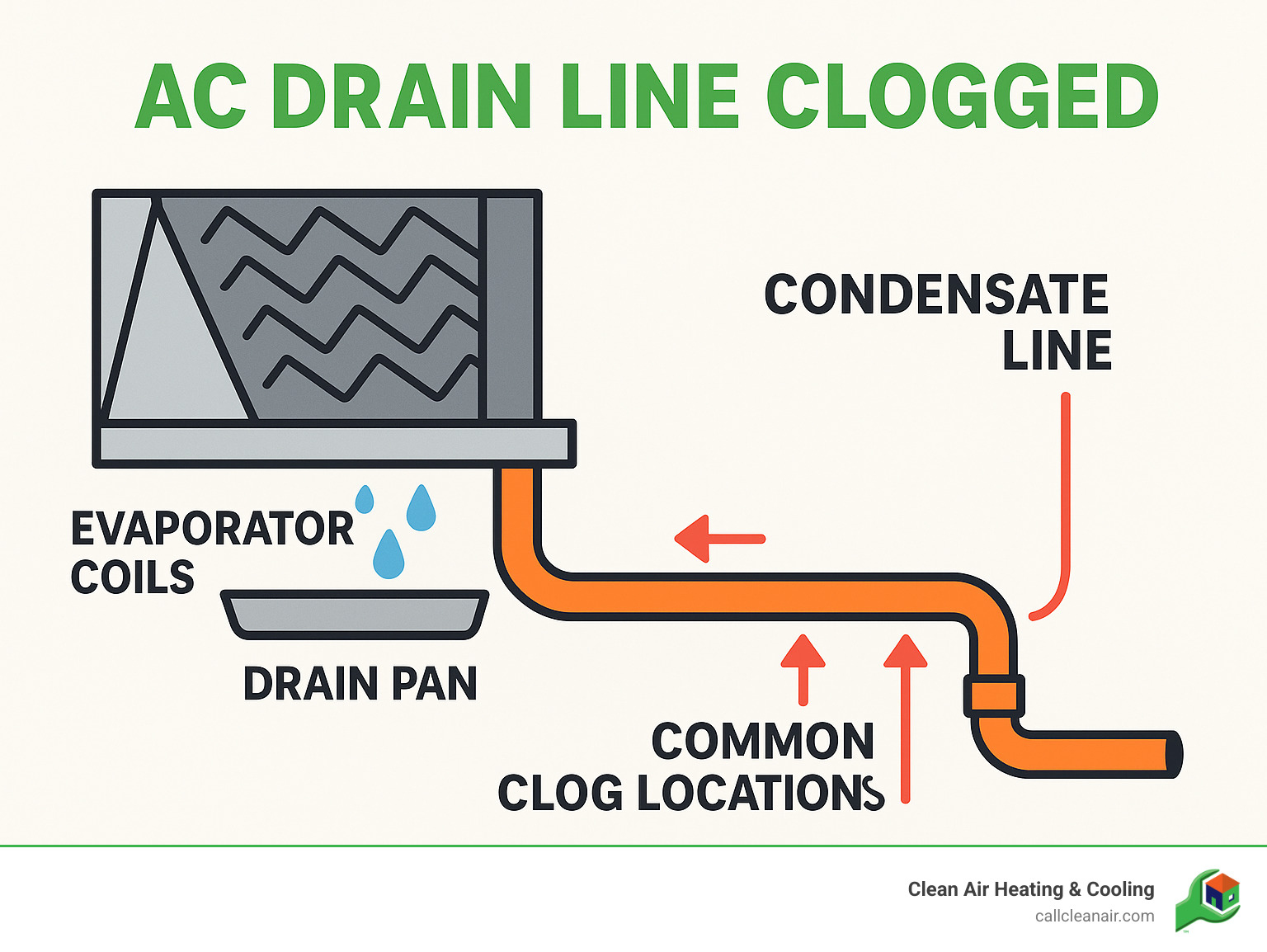
Understanding Your AC Drain Line and Why It Clogs
To tackle a clog, it helps to understand what your AC drain line does and why it gets blocked.
Your air conditioner removes moisture from the air as it cools your home, which is crucial for comfort in the Pacific Northwest. As warm, humid air passes over the cold evaporator coils, condensation forms and drips into a drain pan. From there, a PVC pipe (the condensate drain line) carries this moisture outside. This moisture removal process is key to system efficiency and comfort. When the drain line gets clogged, problems arise.
Common Signs Your AC Drain Line is Clogged
Your AC will usually give you several warning signs before a clog becomes a major issue.
The most obvious sign is water leaks or standing water around your indoor unit. This happens when the drain pan overflows. If your air handler is in the attic, you might see water stains on your ceiling.
Musty or moldy odors from your vents indicate trapped moisture is creating a breeding ground for mold and mildew.
Your home may feel more humid than usual because a blocked drain line prevents the system from effectively removing moisture from the air.
Many newer AC units have a safety device called a float switch that shuts down the AC system when water in the drain pan gets too high. This prevents water damage, though it can be frustrating when your AC won’t turn on.
Finally, inconsistent temperatures can also be a symptom, as a clogged line makes your system work harder and less efficiently.
What Causes a Clogged AC Drain Line?
Clogs are usually caused by a slow buildup of several culprits.
The primary cause is algae growth. The dark, damp drain line is a perfect environment for algae to form a slimy biofilm that eventually blocks the pipe.
Mold and mildew also thrive in these conditions and contribute to the blockage. In the high humidity of Northwest Washington, this buildup can happen quickly.
Dust and debris from your home’s air can bypass the filter and mix with condensation in the drain pan, creating sludge. This dirt accumulation includes pet hair and other small particles.
Environmental factors, like leaves or insects blocking the outdoor drain opening, can also cause blockages. The Pacific Northwest climate is ideal for algae growth.
Improper installation, such as an incorrect slope on the drain line, can cause stagnant water where debris and algae accumulate faster. Understanding these causes is the first step to clearing the line and preventing future clogs.
How to Unclog Your AC Drain Line: A Step-by-Step Guide
Before starting, safety first is crucial, as you’ll be working with electricity and water.
First, turn off power to your AC system at the main breaker box. The breaker is often labeled “AC” or “HVAC.” Also, turn off the disconnect switch near your outdoor unit to ensure the system doesn’t turn on unexpectedly.
For tools needed, gather a wet/dry vacuum, a small funnel, gloves, and rags. A thin wire brush or pipe cleaner can also be helpful.
Step 1: Locate the Drain Line and Access Point
Your AC condensate drain line is a PVC pipe (usually 3/4-inch) located near your indoor air handler, which could be in an attic, closet, crawlspace, or basement. Look for a T-shaped cap or an open pipe extending from the base of the unit. This is the access point for clearing the clog.
Step 2: Attempt to Clear the Initial Blockage
With the power off, remove the cap from the T-shaped access point. Inspect for clogs by looking inside the opening. If you see surface-level debris, gently pull it out with a gloved hand or a thin wire brush. Be careful not to push the clog deeper into the line.
Step 3: Use a Wet/Dry Vacuum to Remove the Clog
A wet/dry vacuum is highly effective for removing the clog. Create a tight seal between the vacuum hose and the drain line opening (either indoors or at the outdoor exit). Use duct tape or a rag to seal any gaps, which maximizes suction. Run the vacuum for 1-2 minutes. You should hear water and debris being sucked into the tank as the blockage is dislodged.
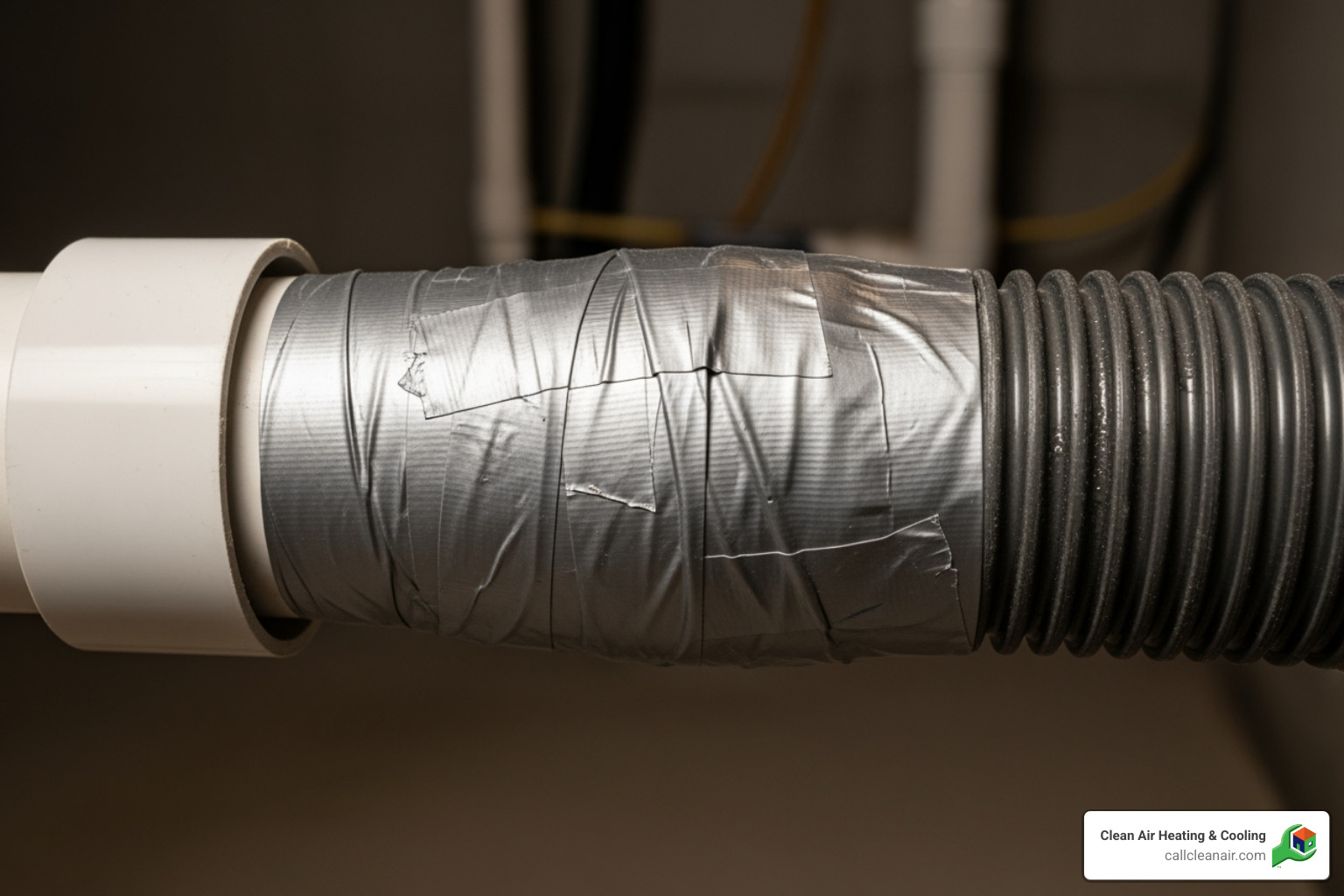
Step 4: Flush the Line to Ensure It’s Clear
After vacuuming, you need to flush the line. Use a funnel to pour about a cup of hot water (not boiling) into the indoor access point. Go outside and check for drainage. If water flows out smoothly, the line is clear. If not, you may need to repeat the vacuuming step.
Once you confirm water flow, replace the cap and restore power at the breaker box. Monitor the system for a few hours to ensure it’s working correctly.
Vinegar vs. Bleach: What’s Best for Cleaning Your Drain Line?
After clearing a clogged AC drain line, you need to keep it clean. The two most common cleaning agents are distilled white vinegar and bleach. Understanding their differences is key to choosing the right one.
| Feature | Distilled White Vinegar | Bleach (Sodium Hypochlorite) |
|---|---|---|
| Pros | Natural, non-corrosive, acidic properties break down buildup, effective against mold/mildew, safer for pipes. | Powerful disinfectant, kills mold, algae, and bacteria quickly. |
| Cons | Slower acting, may not dissolve heavy clogs as quickly, requires more frequent application for prevention. | Corrosive to some plastics and metals over time, can create toxic fumes if mixed with other cleaners, environmental concerns. |
| Safety | Generally safe, minimal fumes. | Requires dilution, good ventilation, never mix with other chemicals. |
| Frequency | Monthly or every few months. | Monthly or every few months, less frequent for prevention. |
Using Distilled White Vinegar
Distilled white vinegar is my top recommendation for regular, gentle cleaning. This natural solution contains acetic acid, which is excellent for dissolving the buildup of algae and mold. To use it, pour one cup of distilled white vinegar into the drain’s access point and let it sit for 30 minutes. This allows the acid to break down residue. Vinegar is safer for pipes and the drain pan than harsher chemicals, making it ideal for monthly maintenance.
Using Bleach (With Caution)
Bleach is a powerful agent for killing mold and algae, but its corrosive properties require caution. Bleach can damage plastic components over time. If you use it, always use a diluted solution (e.g., 1/4 cup of bleach per gallon of water) to prevent damage to the drain pan and PVC pipes.
Crucially, never mix vinegar with bleach, as this creates dangerous chlorine gas. If you switch cleaners, flush the line with water and wait at least a week between treatments.
Due to these risks, I recommend infrequent use of bleach, perhaps only for stubborn growth that vinegar can’t handle. For most homeowners in Whatcom and Skagit Counties, regular vinegar treatments are sufficient.
Preventing Future Clogs and Knowing When to Call a Professional
Preventative maintenance is the key to avoiding emergency repairs and ensuring long-term solutions for your AC. By establishing simple habits, you can prevent a future AC drain line clogged situation and extend your system longevity while avoiding costly repairs.
Best Practices for AC Drain Line Maintenance
A few simple practices will keep your drain line clear.
- Regular flushing with a vinegar solution every 1-3 months during cooling season is your best defense. The vinegar breaks down algae and mold before they form clogs.
- Condensate tablets are a great set-it-and-forget-it option. They dissolve slowly in the drain pan, releasing ingredients that prevent algae growth.
- Changing your clean air filters every 1-3 months is also important. Dirty filters allow more dust and debris into the drain pan, which contributes to clogs.
- Finally, schedule an annual AC tune-up. A professional will inspect and clean the entire condensate system, catching potential issues early.
What are the Risks of Ignoring a Clogged AC Drain Line?
Ignoring the warning signs of a clogged drain line can lead to serious consequences.
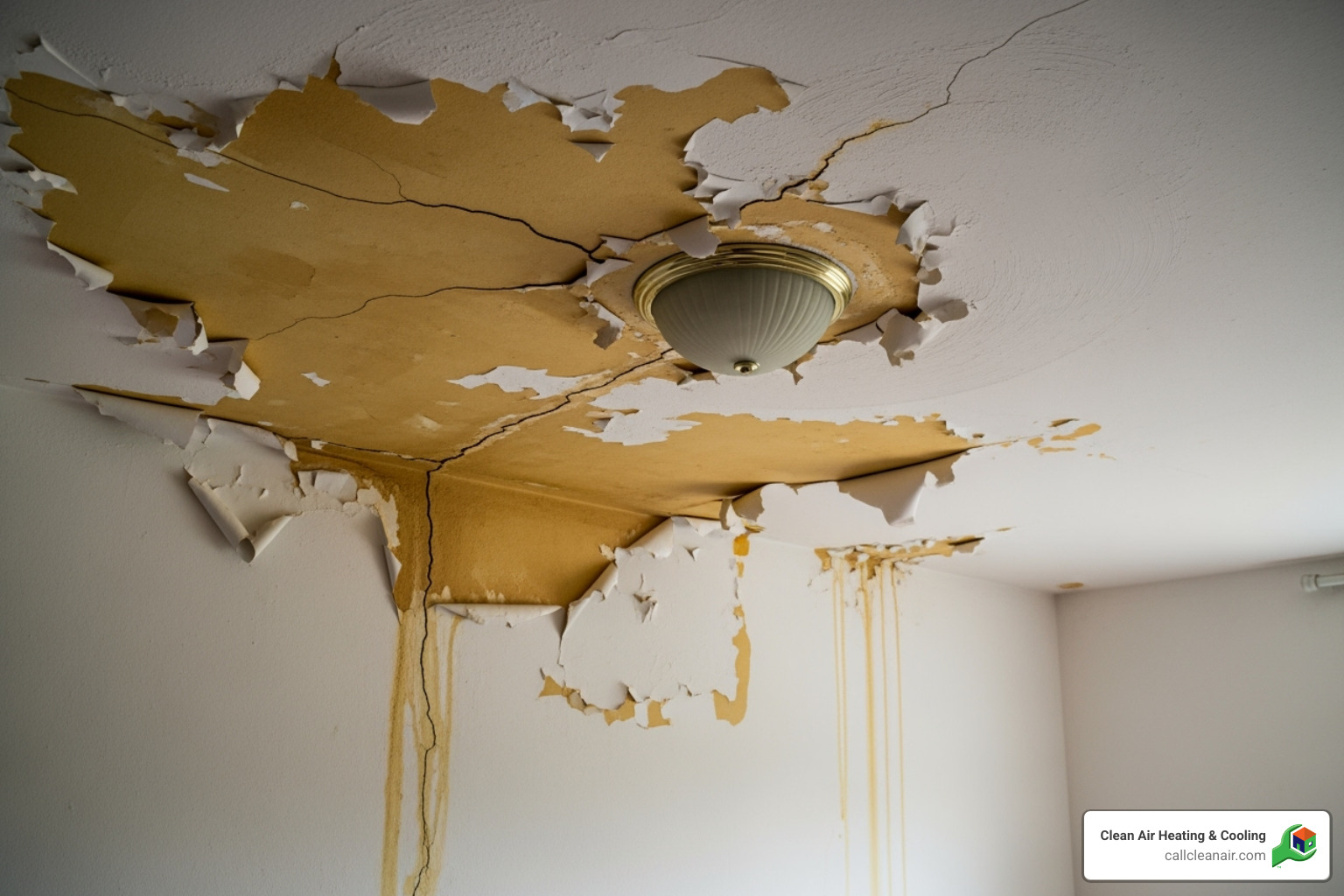
- Serious water damage is the biggest risk. An overflowing drain pan can seep into walls, ceilings, and floors, leading to expensive restoration projects.
- Mold growth is a common result of water damage. It can spread quickly in walls and ductwork, creating health concerns and requiring costly, disruptive remediation.
- Poor air quality results when mold and mildew in your AC system circulate spores throughout your home, which can cause allergies and respiratory irritation.
- Complete system failure can occur if water reaches electrical components like the blower motor or control board. This can lead to major repairs or even require a full system replacement.
When to Call an HVAC Professional
While many clogs are a DIY fix, some situations require a professional.
- Stubborn clogs that don’t clear with a wet/dry vac and flushing may be too deep or severe for DIY tools. Professionals have specialized equipment to handle them.
- Recurring clogs often signal an underlying issue, like improper installation or damage to the line, that requires professional diagnosis.
- If you see any signs of electrical damage (flickering lights, tripped breakers, burning smells), turn off the power and call a professional immediately. Water near electrical parts is dangerous.
- For major water damage, you need an expert who can fix the AC and help coordinate restoration.
- If you have a lack of confidence in DIY methods, it’s always safest to call a pro. A NATE-certified HVAC technician has the training and tools to do the job safely.
Frequently Asked Questions about a Clogged AC Drain Line
Here are answers to the most common questions homeowners have about a clogged AC drain line.
Will my AC unit shut off if the drain line is clogged?
Yes, most modern AC systems will shut off. They are equipped with a float switch (or condensate overflow switch) in the drain pan that monitors water levels. When the drain line clogs and water backs up, the float switch is triggered, sending a signal that shuts down the entire AC system.
This safety feature is crucial for system protection and preventing water damage. The inconvenience of a shutdown is far better than dealing with a flooded home. If your AC suddenly stops on a hot day and you see water near the indoor unit, a clogged drain line and an activated float switch are the likely culprits.
How often should I clean my AC drain line?
For preventative cleaning, I recommend cleaning your drain line every 1-3 months during the cooling season, especially in high-humidity climates like the Pacific Northwest where buildup occurs faster. In humid areas, aim for monthly cleaning; in drier climates, every three months is usually sufficient.
At a minimum, make it part of your seasonal maintenance. Flush the line before cooling season begins and again mid-summer.
Can I use chemical drain cleaners in my AC drain line?
Chemical drain cleaners are not recommended for your AC drain line. The harsh chemicals in these products are designed for heavy-duty plumbing and can damage PVC pipes, making them brittle or causing cracks. They can also damage your drain pan, especially if it’s metal, and using them may void your warranty.
These cleaners also produce fumes that are dangerous to breathe in enclosed spaces like attics or closets. Stick to vinegar or diluted bleach. These solutions are safer and effective for the biological clogs common in AC drain lines. If these methods fail, it’s time to call a professional.
Keep Your AC Running Smoothly
Fixing an AC drain line clogged issue is about protecting your home and comfort. With the regular maintenance and DIY cleaning methods we’ve covered, you can prevent most frustrating breakdowns.
A few minutes of preventive care each month improves system efficiency and saves you from the stress of water damage and emergency repairs. A clear drain line allows your AC to remove moisture properly, so it works less to keep you cool, ensuring your home comfort.
We believe in empowering homeowners, but we also know that sometimes you need professional help. At Clean Air Heating & Cooling, we serve Whatcom, Skagit, Snohomish, and San Juan County residents with honest, reliable solutions. Whether you have a stubborn clog, want a professional tune-up, or need advice on a new installation, our team is here to help.
If you’ve tried these DIY steps and still have issues, or if you’d prefer a professional handle it, we’re ready to help.
Schedule your AC repair in Bellingham, WA today, and let our experienced team help you keep your air clean, your home cool, and your summer plans on track!

